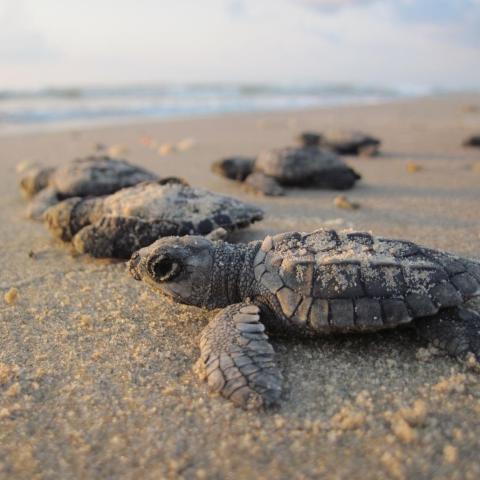At first glance, the latest foreign invader to threaten Florida ecosystems doesn't seem nearly as impressive as Burmese pythons, whose length can exceed ten feet, or lionfish, whose colorful spines can deliver a venomous sting. Despite its small size, however, the wider impact of the "New Guinea flatworm" could eventually be even more serious than that of the pythons.
This invasive land planarian, officially known as Platydemus manokwari (Platyhelminthes, Geoplanidae), is such a threat that it's been listed as one of the "100 worst invasive species in the world," according to the Invasive Species Specialist Group of the International Union for Conservation of Nature (IUCN).
Until recently this species was not known to occur in North America, but that's changed, says Jean-Lou Justine, the lead author of a study published on June 23 in the online science journal PeerJ.
First Reported Sightings for the American Continent
According to the study, "The new reports from Florida and Puerto Rico are firsts for the USA, for the American continent, and the Caribbean. P. manokwari is a known threat for endemic terrestrial molluscs and its presence is a matter of concern."
“The discovery of this species in mainland America should be considered very bad news for biodiversity,” said Justine. “It is a predator of land snails and of many other soil invertebrates. It can endanger existing populations of rare and threatened endemic snails.”
For many people, a threat to the survival of snails may not be a pressing concern, but Dr. Piero Genovesi, senior conservation officer at the Institute for Environmental Protection and Research, explains that this problem should not be taken lightly.
"It is important to remember that land snails are a major component of the entire faunal diversity of North America, and a key element of the ecosystems of this region," Genovesi said. "Land snails, a particularly important group globally with a very high number of species, are incredibly vulnerable. This group has the highest rates of extinctions,” he adds.
Potential Impacts Not to Be Taken Lightly
If the supply of snails has been reduced, these predatory flatworms can also target earthworms, which also play an important role in the environment in North America. Impacts of this invasion could also be felt up the food chain on other species that eat snails, and that includes birds.
"While most of the infected territories reported until now were islands, the newly reported presence of the species in mainland US in Florida should be considered a potential major threat to the whole U.S. and even the Americas," the study notes. The flatworms appear to be incapable of travelling long distances on their own, but they can easily be passively spread as part of the movement of infested plants, plant parts and soil.
There's no indication these latest pests have turned up in South Florida parks such as Everglades National Park and Biscayne National Park, but given those areas' proximity to known sightings in Miami, it's certainly one more matter of concern in those areas.
No Natural Predators and Hard to Spot
Like many other invasive species, there are no known natural predators for these flatworms in North America, and the worms have a bitter taste, so they're not an appealing food for birds. Their small size makes them difficult to detect, and they are usually nocturnal, so the best odds of spotting these creatures involve use of a flashlight after sundown. Justine suspects they "have probably already spread to many gardens in Miami, since these are often attended by professionals with many clients. Movements of the flatworm from garden to garden together with soil, compost, rooted plants, potted plants and garden waste will certainly disseminate the invasive species,” he adds.
These slimy creatures are hardly appealing to humans, so some other exotic species, people aren't likely to be wanting to keep them as pets. The black-and-olive colored flatworms have a pale white belly, a mouth in the middle of the belly and an elongated head with two black eyes. They grow to a length of about two inches.
If you're in Florida—the only known U. S. location of these pests to date—and you believe you've spotted one of the flatworms in a potted plant or your garden, officials ask you to mark the location, take some photos and contact the Florida Fish and Wildlife Conservation Commission. Instructions are available at this link.
Handle With Care
You might also consider scooping the worm up with a small hand tool and confining it in a closed container until identification is confirmed, but Justine recommends not touching it. “Land planarians produce dangerous chemicals and release them with their mucus, which is a protection against possible predators,” he says. “These chemical substances can be toxic and could induce allergic reactions.”
Add this one to a list of challenges for scientists to figure out a control method that doesn't create its own set of problems, and there's an ironic lesson in that regard.
Some years ago, these predatory flatworms were deliberately introduced into some Pacific islands in an attempt to control an invasion of the Giant East African Snail. In the process, the worms were also accidentally introduced to the soil of other Pacific countries. As a result, according to the Invasive Species Compendium, the worms have had "a significant negative impact on the rare endemic land snail faunas of some Pacific islands, and have become established in a wide variety of habitats."
One very basic method of control—simply chopping the little beasts into pieces when you catch one—isn't the solution. Biologists note that "if the flatworm is divided into several pieces, each piece regenerates into complete animals in 2 weeks."
If there's any good news, at least these invaders are small, move slowly, and aren't nearly as intimidating in appearance as a ten-foot-long python . . . unless you happen to be a snail or an earthworm.





 Support Essential Coverage of Essential Places
Support Essential Coverage of Essential Places






